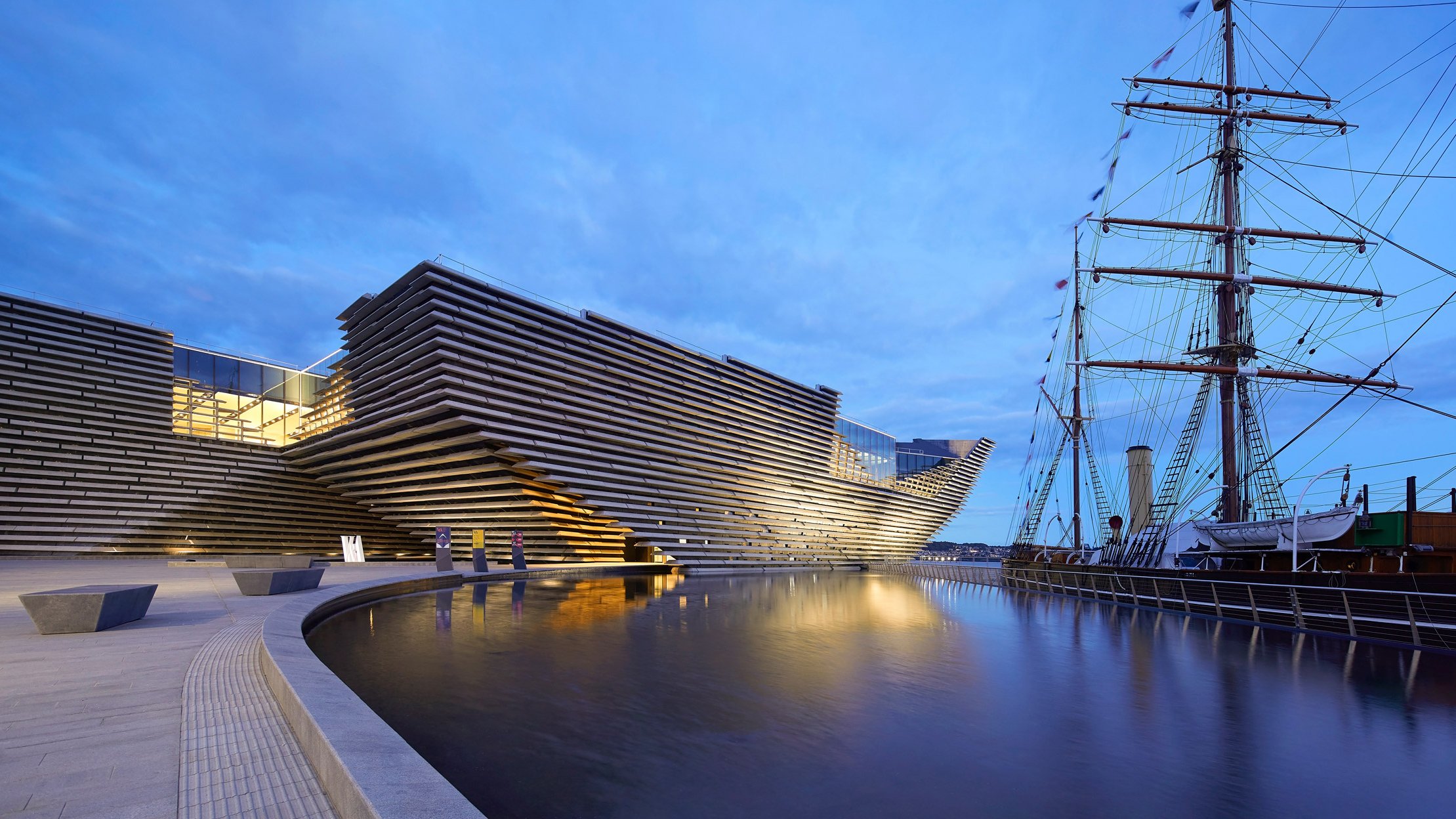Dundee’s V&A: Re-Evaluating the Role of the Museum in a Post-Covid World
By Lucy Evans
The V&A Museum in Dundee, conceived of specifically as a new public space for the city, recently led me to think about the social function of museums and the extent to which they are integrated into the social and material fabric of their communities. Visiting the V&A on a rainy, grey day when the museum was between large, blockbuster-style exhibitions, I was struck by how animated the place (“building” feels like too reductive a word) felt. It was obvious that this museum functions as more than solely an exhibiting space: it is a social space, a meeting-place, a declaration of identity for the city and a source of creative inspiration for Dundee’s inhabitants and visitors – all embodied in its striking and eloquent form.
I first spent some time reading about the building itself, which has an iconic appearance undergirded by significant conceptual ideas relating to a building’s integration with its environment. A series of interactive and audio-visual content in the museum’s initial entranceway explores the building from its beginnings to its construction. The V&A’s architect, Kengo Kuma, speaks of the importance of the building being integrated with nature (reflecting a central tenet of his architectural practice), which in this case implies a seamless blending of the building with the river and the sky – as well as the built environment of this harbourside stretch of Dundee. One of the sources of inspiration for the building is Scotland’s cliffs, which can be seen reflected in the museum’s shape, with its steep and jagged edges and oblique walls – a structure also reflective of the “toughness” of Scotland’s natural environment. Originally, this futuristic building was intended to rise out of the river Tay. Ultimately, the museum was brought inland, but the water is still central to the building, flowing around and under it in shallow pools which give the same effect as a building emerging from the water.
Detail of water feature in the V&A Dundee, Kengo Kuma, 2018. Photograph contributed by author.
Kengo Kuma speaks of the museum as being like ‘a living room for the city, drawing people in’. This articulation of intent for the museum stood out to me, since, even as a visitor from outside of Dundee, I really felt that sense of ease, relaxation and openness (to every visitor and to different forms of leisure and activity outside of the strictly intellectual) from the museum. It seems to me that the V&A conveys an institutional purpose which is compassionately engaged with its audience. It warmly brings people into its exciting space, and it offers literal and metaphorical shelter – from the banalities of daily life and from the Scottish wind and rain alike!
Small features in the museum struck me as deeply thoughtful: armchairs positioned facing out to the river encouraged a sense of relaxation and homeliness in the building whilst also prompting reflection (considering the sublime view of the River Tay which stretches beyond a large glass wall). In this same hybrid space, there were areas for eating and for creative activities. Both profound and quotidian, spaces like these highlight the importance of such de-commodified and pressure-free spaces of belonging in a city. I would not be surprised if this museum contributed to a Dundonians’ sense of pride in their city and perhaps even their own self-esteem. Indeed, Nuala Morse speaks of how cultural outreach activities can help people to connect with themselves as well as others, whilst also providing ‘joyful distraction and creative engagement’. I would argue that the V&A embodies a caring role within its city; it has a consciousness which is focused on its public perhaps even more so than its collection, therefore making it a fundamentally people-focused institution.
Exterior View of the Museum with the HMS Discovery. Kengo Kuma, V&A Dundee, 2018, Dundee, Scotland.
Recent academic literature has discussed how the relevance of museums can be renewed through care work and through the ‘communal work of repair’ made possible through care work provided by the museum. This focus on care requires a reconsideration of the role of the museum in terms of its social role in serving people, and the importance of this focus perhaps above and beyond its care for objects and its collection. The COVID-19 pandemic highlighted the importance of care and mutual support within communities, and museums responded by increasing their outreach and community engagement activities. Examples of such outreach work includes sending out creative packs to people who were vulnerable and shielding, phone calls for the elderly and online sessions for mental health service users. All these activities were focused on the importance of connection despite the closure of actual buildings, a fact which highlights the sense of social responsibility that museums have nowadays. This ‘trend’ can be illustrated by the establishment of the National Centre for Creative Health in the UK in 2021, which aims to promote the integration of culture with healthcare systems in order to tackle healthcare inequalities. This provides an example of how museums and galleries can engage practically with health and care provision. Overall, it is possible to see how the role of museums in society is shifting from that of authoritative archives of knowledge and storehouses of material culture(s) to institutions focused on engagement with their audiences and outreach within their communities.
References:
Morse, Nuala. “Care, repair, and the future social relevance of museums.” Museums & Social Issues 15, no. 1-2 (2021): 28-38.


